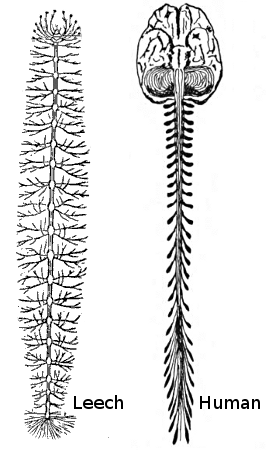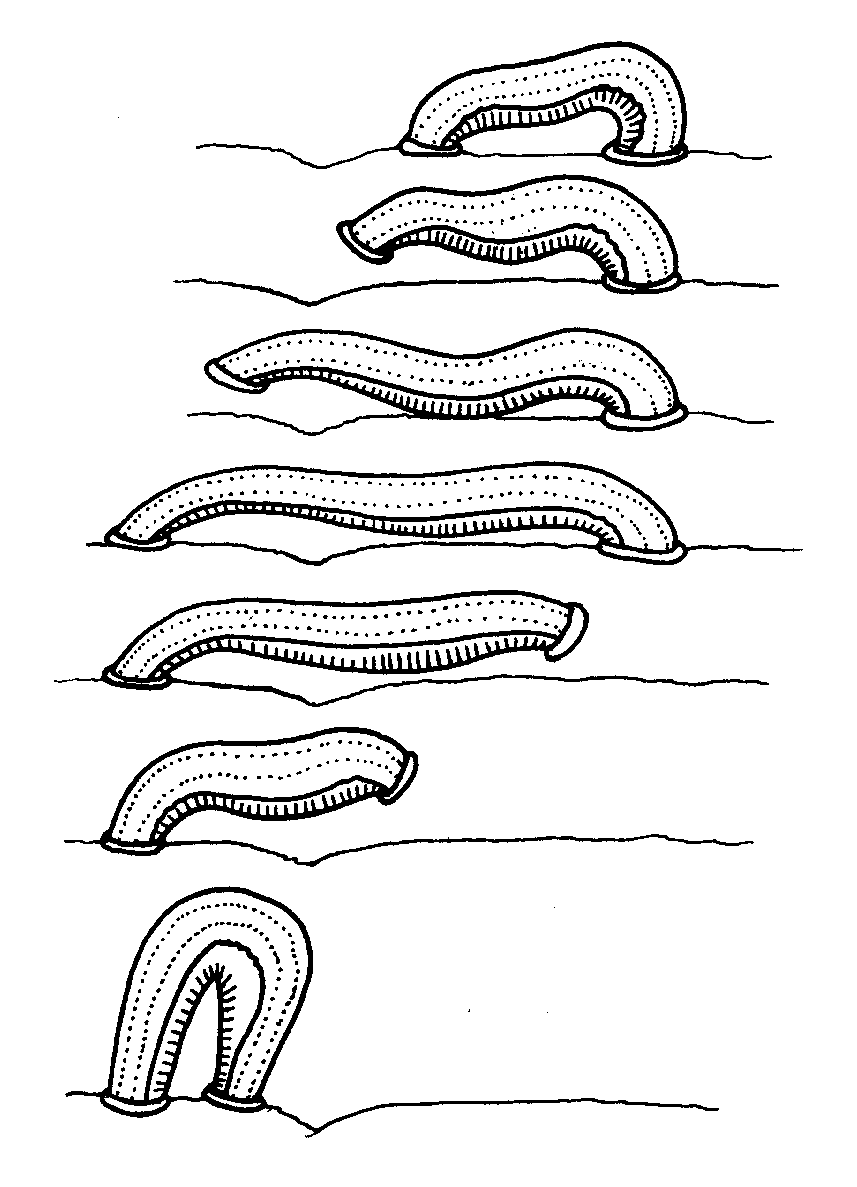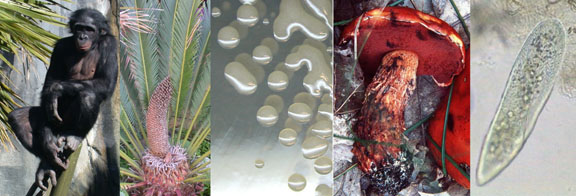
Sensing the Environment
As mentioned in
the Habitat
section, H. medicinalis mostly
lives in freshwaters, and less often on land. What adaptations has
the leech developed to survive in these conditions? How does the leech
sense
its environment? Read on to find out.
Cephalization,
segmentation, and bilateral symmetry are major
accomplishments in the evolutionary advancement of animals and have
allowed annelids
with several advantages. Bilateral symmetry and segmentation have
allowed
certain parts of the body to become specialized, allowing for organs
and areas
of the body to become more apt to the environment. Segmentation has led
to
cephalization—the concentration of nervous tissue at one end of the
body.
Cephalization is extremely important since it allowed for the
development of
ganglia and a nervous system in the annelids.
As the picture to the left shows, the nervous systems of a leech and human have some similarities. The most obvious is the central nervous tissue and ladder-like nerve network. Hirudo medicinalis has a central nervous system consisting of 34 pairs of ganglia that branch off from it. The motor nerve cells are located in the ventral nerve cord and the sensory nerve cells are concentrated in or around the sense organs.
The
leech senses its environment in several ways. H.
medicinalis has five pairs of "eyes" around its head, but are pretty
simple in structure and function compared to ours. They have no lens,
rods or
cones, but only light-sensitive cells that allow them to differentiate
light
and dark. The leech also has chemoreceptors near their head that allow
them to
sense different chemicals. They have large concentrations of nerves in
their
epidermis that allow them to detect movement in water as well as touch.
All of these adaptations are important in the leech’s survival. First, the light receptors allow them to know their position in the water. If they sense more light, it probably means they are close to the surface of the water, a possibly dangerous place since a bird or another animal could easily come and grab it. If a cow or some other animal came near a pond where the leech was waiting, it could see its shadow and approach it for a meal. So, although the eye of the leech is simple, it serves an important function and aids in its survival. Second, the chemoreceptors in the leech allow them to detect possible food sources. These chemoreceptors may be analogous to our nose and the way we smell different chemical compounds. The leech can "smell" different prey and can close in on them for lunch. Also, their epidermis is lined with sensitive nerves that allow them to detect vibrations from possible prey in the water. If they sense some type of disruption in the water, they often go to investigate it and use their chemoreceptors to determine whether or not it is edible.
I'm
an avid fisherman, and I often use leeches from the local bait shop to
attempt to catch the "big ones". Leeches have adapted a
unique wave-like motion that they use to swim through the water and
fish like northern
pike and large mouth bass are often
attracted by it. H.
medicinalis also
uses this characteristic motion to get around in the water quite
elegantly. Below is a YouTube video that shows this movement.

"Looping"
Leeches also utilize a type of "inching" movement that allows them to move along the bottom of a pond or lake, and also on land. They relax their muscles, making their body stretched out and elongated. The leech can then grab on to the substrate in front of them with their sucker, and then contract their muscles bringing forth their backside. Although this movement isn't nearly as fast as their wave-like swimming, it serves the leech with a good purpose, allowing them to be motile in water and on land. The picture to the right illustrates this type of movement.
As
mentioned above, leeches like Hirudo medicinalis
are sometimes on the
top of the menu for many different types of organisms. Of course, no
organism wants to be dinner and most have developed ways to avoid
getting eaten. Some organisms have poison, spikes, claws, and scary
mannerisms that help them out. However, in the case of leeches, their
main line of defense is quite simple--they hide. They
spend most of their time buried in the muddy bottom of a pond to avoid
attracting their enemies, and in most cases it works for them.
| Click on the link below to visit the University of La Crosse website | Click on the link below to see other organism websites made by UW-L students at multipleorganisms.net |
 |
 |